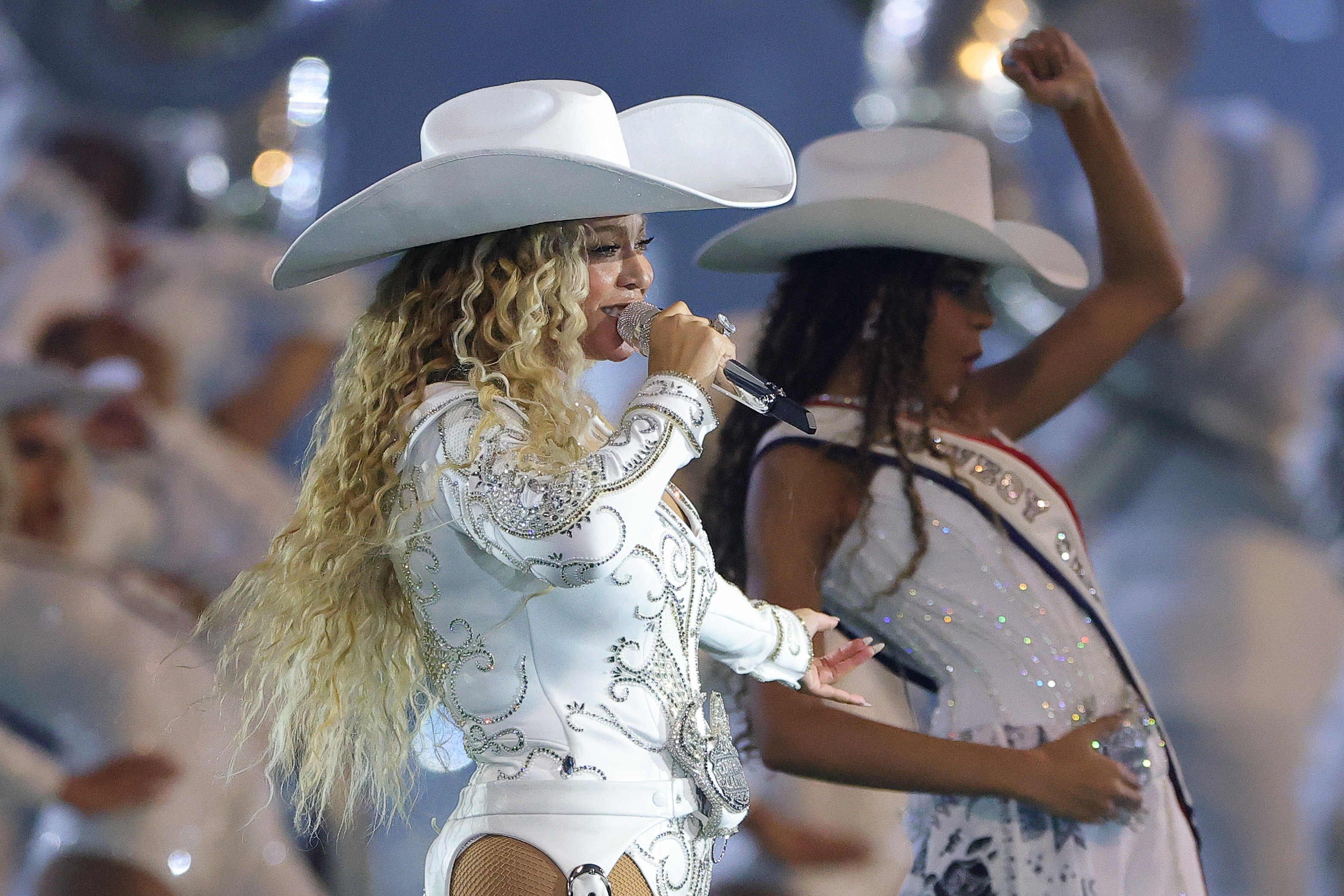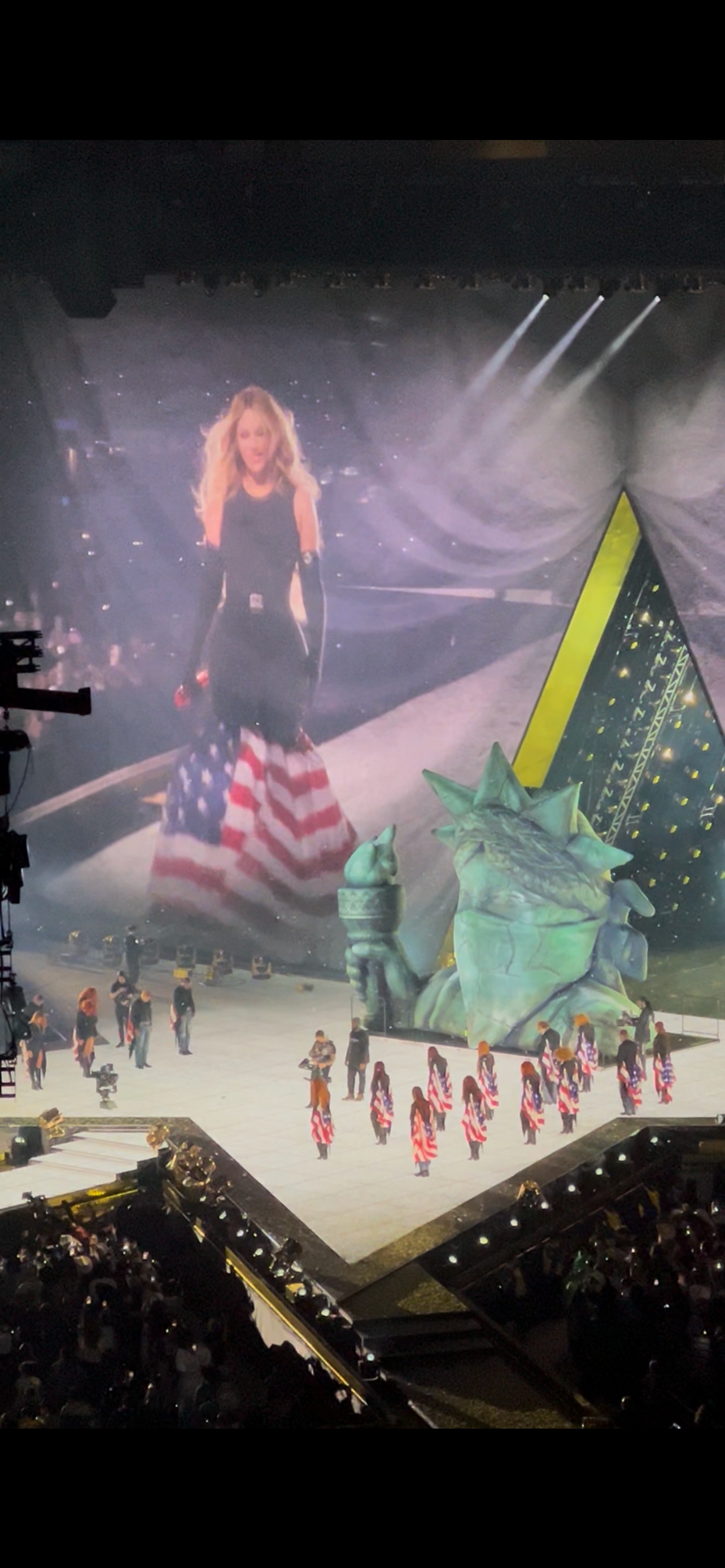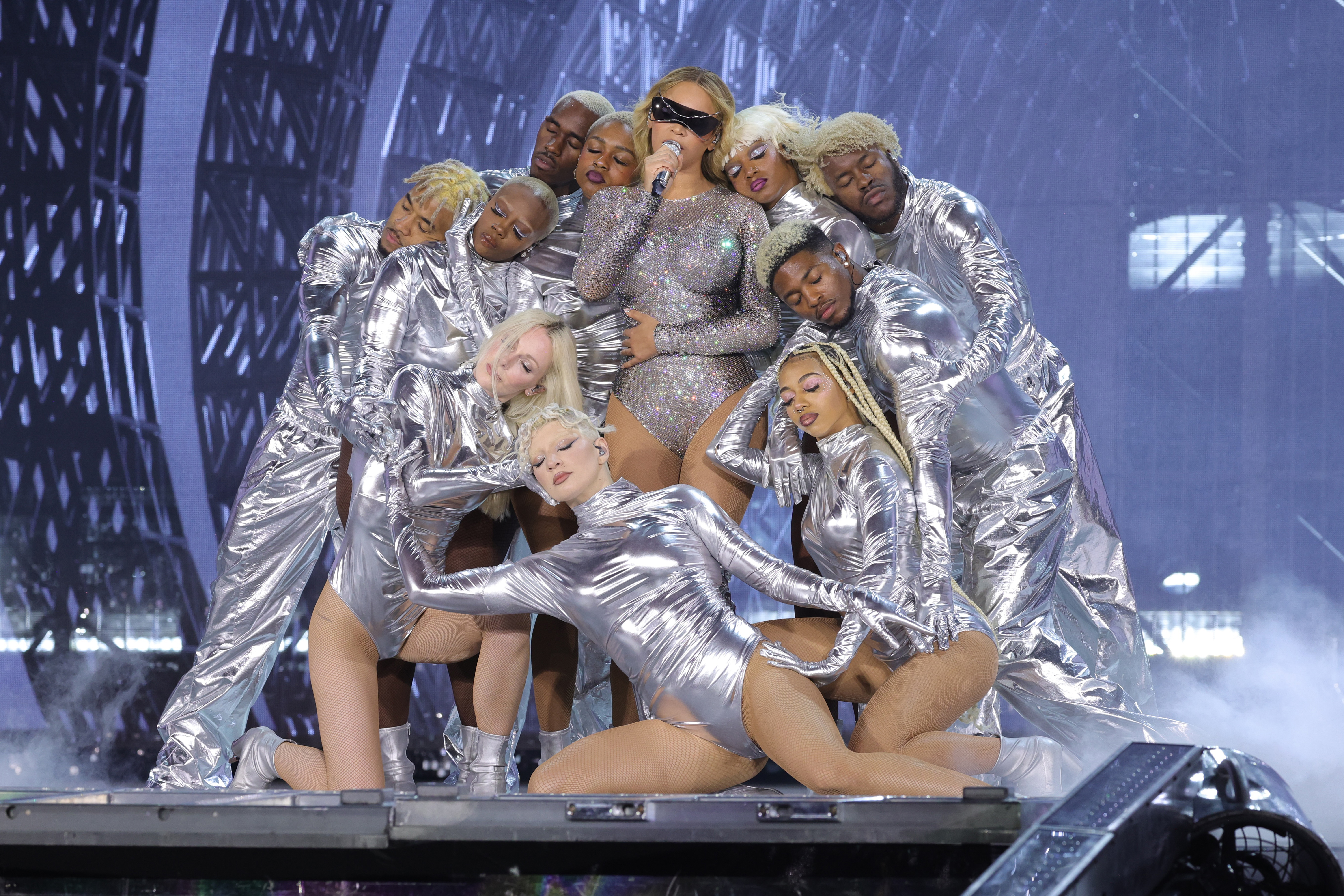Beyoncé Battles Her Gatekeepers on the 'Cowboy Carter' Tour
And proves the best use of her power is looking beyond them.


Nine years after being snubbed by country music’s elite, Beyoncé opens the Cowboy Carter Tour, not by shying away from the controversy that spurred its namesake album, but by demonstrating the power of protest.
The first bars of the lead track on her 2024 album, “American Requiem,” kick off the show in complete darkness, leaving the audience to focus on the gospel-tinged challenge to America’s original sin. Minutes later, her rendition of “The Star-Spangled Banner” is backed by Jimi Hendrix’s acerbic riffs from Woodstock, bringing the politicized performance 55 years into the future. As she sings, “History can’t be erased,” during “Ya Ya,” the screen behind her punctuates the lyrics with archival footage of civil rights marches. The frenetic, emotional, joyous first minutes of her latest stadium tour delivers the message with the subtlety of a sledgehammer, but, like Bey herself, it’s bombastic in its euphoria. I’ll sum it up in the feeling that washed over me after reading an essential edict displayed on stage, several stories tall: “Never ask permission for something that already belongs to you.”
A post shared by Beyoncé (@beyonce)
A photo posted by on
This segment of the concert is exactly why Cowboy Carter holds a special place in my heart. As I wrote last year, I see Beyoncé’s unapologetic exploration of these genres—in which white gatekeepers have tried to erase Black influence—as a reminder to never allow bigots to tell me where I don’t belong. Still, the Cowboy Carter Tour is taking place during a very dark time for America, and when I was invited by SoFi to see the concert at the L.A. stadium, I was at a down point in my mental health, finding it very hard to retain that sense of hope and resilience. And I know I’m not alone in feeling like this.
Beyoncé directly confronts these thoughts in her searing visual interlude between “Ya Ya” and “America’s Got a Problem.” Mixing Ras Baraka’s “American Poem” with an upbeat jazz-flute melody, she combines archival videos with childhood footage, placing her own performances next to legendary musicians who inspire her, like Chuck Berry, Little Richard, and Tina Turner. But then, the exuberant clips of Black expression are interrupted by news reels of white commentators’s outrage over the singer “inserting herself” into a genre that has been part of her DNA since she was born and raised in Houston, Texas. Here, Beyoncé proves her point to an audience of 70,000 people and whoever sees photos and video of the live show online: America has always been Black, even if you don’t want to admit it. And you can’t stop us from celebrating it.
I see Beyoncé’s unapologetic exploration of these genres—in which white gatekeepers have tried to erase Black influence—as a reminder to never allow bigots to tell me where I don’t belong.
The first 40 minutes of the Cowboy Carter Tour were the righteous, corroborated reclamation I needed, but the message gets lost in the second half as the concert becomes purely an experience in Beyoncé. This tour, which launched on April 28 and lasts until July 26, is the singer’s longest concert to date; at two hours and 45 minutes, it surpasses the length of its namesake album. When I attended night three in L.A., the singer followed up the spectacular opening with two more segments running straight through Cowboy Carter, before expanding the scope again to include more of her previous work. The concert quickly becomes less focused on the message and more on the experience of seeing this genreless project performed live. The visuals also lose their archival bent, with Beyoncé instead inserting herself into Wild West imagery and classic cinema. The setlist becomes an undirected exploration, with mash-ups and song transitions pulling from every single era of her over 30-plus years as a musician, even the Destiny’s Child years and deep cuts like 2020’s Black Is King.

Beyoncé is joined by her daughter Blue Ivy on the Cowboy Carter Tour, as she was during her Christmas 2025 halftime show at NRG Stadium in Houston, Texas.
This left me a bit jarred when the show jumped right back into symbolism for the closing act. The 35-time Grammy winner saves “16 Carriages” for the finale, as she rides a flying car over the arena floor. It seems like the perfect sendoff, with Bey’s lyrics reminiscing on a career of sacrifices. She even brings back the patriotic imagery in full force; she and her dancers wear looks featuring the American flag, with a giant effigy of a masked Statue of Liberty erected on the stage. Though the styling throughout the whole show played with the colors red, white, and blue, the finale is the only time she wears the American flag, which, despite the evening of assurances that America is as much hers as anyone’s, is still a subversive act.

My view of the 'Cowboy Carter' tour's closing stage.
Even with all that, the closing act didn’t land for me, and I left the concert thinking more about Beyoncé the figure than Beyoncé the artist. Though I’ve admired Beyoncé my entire life—I still have half of her choreography memorized from watching her videos over and over as a kid, and I count B'Day, Lemonade, and Renaissance among my top 20 albums of all time—my critical brain often grapples with the distinction between her artistry and business. Concertgoing sits in a weird space of jubilation through commerce; fans attend to experience a transcendent communal experience, but they pay increasingly high ticket prices, and possibly even go into debt, to access it. Ideally, the awe of the large-scale performance is enough to make every attendee forget the complicated world and just live in the music. I reached that elation early in CC’s runtime, tears and all, but by the second hour in, I couldn’t stop getting distracted by the neon Cecred and Sir Davis displays on the stage walkways, and the economics of the whole night. I wasn’t thinking of the much-needed archival history lesson two hours prior; instead, I wondered how she removed the Sphere from her Attack of the 50 Foot Woman interlude so quickly. I was thinking of money and capitalism, and power, and what that reclamation serves. Does a multi-millionaire married to a billionaire really need to be reclaiming symbols of a country built on capitalist exploitation? Is there a more effective use of Beyoncé’s artistry?
Get exclusive access to fashion and beauty trends, hot-off-the-press celebrity news, and more.

Beyoncé briefly reprises the Renaissance World Tour, pictured above, near the end of the Cowboy Carter Tour's setlist.
The Cowboy Carter and Renaissance eras did similar things. Both amplified forgotten Black trailblazers who crafted genres of music that often don’t give them credit. Both are celebrations of Black resilience and artistry, as well as defiant proclamations within their very existence. But Cowboy Carter’s most common critique, one I share, is that it’s trying to accomplish so much. In addition to being an ethnomusicology lesson, it’s also an artist’s declaration that she deserves recognition beyond boundaries in today’s music landscape. (It succeeded, hence her Album of the Year win at this year’s Grammys.) Compare that with Renaissance, which fills its space with innovative archival sampling, visibility for marginalized trendsetters, and a carnal joy welcoming a brighter future. In its final 30 minutes, the Cowboy Carter Tour briefly reprises Renaissance’s first three songs in the exact staging from the 2023 mega-tour, and returning to Renaissance’s chrome, Afrofuturistic utopia, reiterating what Beyoncé is capable of outside of all that reimagined Americana.
Beyoncé’s reclamation of country and Americana is important and powerful, but it’s not without its baggage. At the same time that it’s pivotal and empowering that she’s amplifying the rightful Black music legacy that mainstream country tries to hide, her message can also be muddled by her iconography and the complicated class politics it evokes. I’m glad as a fan and a critic that both Cowboy Carter and its Tour exist, but Renaissance was more successful to me as both a body of music and an era. One was about reclaiming the past and demanding space in the present, the other revived the past to welcome it into an exciting tomorrow. One Beyoncé is influential, the other is essential. And while I’m glad the Cowboy Carter Tour has both, I hope the next act focuses on the latter.

Quinci LeGardye is a Culture Writer at Marie Claire. She currently lives in her hometown of Los Angeles after periods living in NYC and Albuquerque, where she earned a Bachelor’s degree in English and Psychology from The University of New Mexico. In 2021, she joined Marie Claire as a contributor, becoming a full-time writer for the brand in 2024. She contributes day-to-day-content covering television, movies, books, and pop culture in general. She has also written features, profiles, recaps, personal essays, and cultural criticism for outlets including Harper’s Bazaar, Elle, HuffPost, Teen Vogue, Vulture, The A.V. Club, Catapult, and others. When she isn't writing or checking Twitter way too often, you can find her watching the latest K-drama, or giving a concert performance in her car.